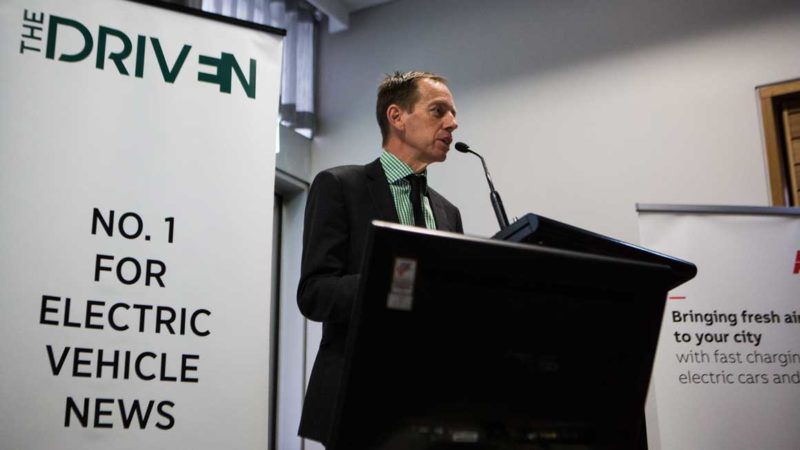The ACT’s plan to decarbonise transport is picking up pace and is set to take centre stage as the capital territory completes its shift to 100 per cent electricity and the first phase of its goal of zero emissions by 2045.
Climate minister Shane Rattenbury detailed the progress the ACT has made in a keynote speech to the Electric Vehicle Transition conference co-hosted by The Driven and RenewEconomy in Sydney on Tuesday, and said it was well within reach of its goal of newly leased vehicles for government fleets to be 50% by 2020 and 100% by 2021.
And he says that early feedback had demonstrated the economic benefits – as well as the environmental ones – echoing the observation by Anna Skarbek of Climateworks on the first day that electric vehicles were already providing a cost-competitive alternative to petrol and diesel vehicles for local government fleets.
The ACT has led the country in the adoption of renewable energy, instigating a series of reverse auctions that is credited with keeping the industry afloat during the dark period of the Abbott government which tried to scrap the renewable energy target.
During the 2018/19 financial year, the ACT lifted its share of renewables to 74 per cent of electricity and this will become 100% from 2020 onwards (in fact, within a few months as the last contracted wind farm starts to deliver).
Rattenbury says decarbonising the grid will deliver a 40 per cent cut to overall greenhouse gas emissions reduction by 2020 from 1990 levels, and it means that in the ACT, transport instead will become the largest contribution of carbon emissions, representing a hefty 61%.
With 95% of those transport-related emissions coming directly from private transport. Rattenbury says this task is not without its challenges, and the government had responded by setting a series of interim targets.

“We wanted to do things over a short time frame within our jurisdiction,” Rattenbury says. “This is a transition that is coming and we need to make sure our community is prepared for it.”
He noted that the savings were already visible. The cost of running the EVs was just 3c/kWh, compared to 10-12c/kWh for the fossil fuel equivalent – delivering $1500 of savings a year per vehicle. Like Skarbek, he noted that leasing over four years is now cost comparative.
But while the ACT currently offers the most generous incentives to assist private consumers shift to zero emission vehicles (ZEVs,) including zero stamp duty and a 20% discount on registration for zero emissions vehicles, Rattenbury says there is a limit to what the states and territories can do.
“We really need the engagement of the federal government,” says Rattenbury.
Along with targets for government fleets, the ACT government is also looking at ways to ensure all new multi-unit apartments can install infrastructure in basement carparks, avoiding post-build and therefore much more expensive retrofits.
Other incentives may include allowing ZEVs – which includes battery electric and hydrogen fuel cell electric vehicles – to use transit lanes for the next 5 years, with the assumption that within that time there would be enough EVs, so that offering that incentive is no longer necessary (and also to avoid clogged transit lanes).
Rattenbury says the shift to EVs is already being embraced by members of the public sector, such as nurses in the ACT health system who have access to electric Hyundai Ioniqs as fleet vehicles for home visits.

One facility manager who was previously dubious about EVs is now a “tremendous champion”, Rattenbury says, and has become an ambassador for the shift to ZEVs across agencies after recognising the benefits, including health, cost-wise and environmental.
Transitioning fleets to ZEVs can also go a long way towards building a secondhand car market, says Rattenbury, a fact that was echoed by CEFC debt market expert Grace Tam at The Driven conference on Tuesday.
Currently, the (CEFC) Clean Energy Finance Corporation funds projects that are designed to break down barriers to decarbonisation of transport in the quickest possible way, lending money to organisations to achieve carbon reduction goals.
One of these opportunities is via transitioning fleets, Tam says.
A secondhand fleet offering electric vehicles to private consumers builds a demand pipeline, that in turn breeds confidence in carmakers to import electric vehicles (as Australia has no car industry of its own anymore), creating further benefits to consumers.
Another interesting project the ACT is undertaking that came out of Monday’s talks was discussed by Rattenbury’s predecessor Simon Corbell, who said that the ACT government has commissioned $1 million worth of light rail infrastructure that will further cement the capital territory as a progressive leader in the move to zero emissions.
The ACT government plans to capture energy that is currently lost by its train network through regenerative braking and divert it instead to power electric vehicle chargers for passengers along the train route.
The current train network currently loses 30% of its energy through braking, Corbell said, who is now chief advisor for Energy Estate – but the new system planned by the ACT will leverage existing infrastructure.
“The opportunity is to see that network as a place that captures and generates power and puts that into the grid and out to electric vehicle charging.”
By utilising existing traction substations and adding battery storage along the route, the Canberra metro light rail operator CMET will capture the energy and be able to offer EV charging stations for commuters.
With the train route in the ACT running north-south, electric buses also currently being considered by the ACT servicing existing east-west routes have the potential to charge from the substations also.
According to Corbell, the project – which intelligently makes use of existing infrastructure instead of spending on an entireley new system – has the potential to make the case for the transition of other train networks around the country.
“It’s about how we integrate EVs with existing networks, how we think about our cities and how to integrate existing infrastructure,” says Corbell.
“If we can do it in [the ACT], we can do it in many other cities around Australia.”

Bridie Schmidt is associate editor for The Driven, sister site of Renew Economy. She has been writing about electric vehicles since 2018, and has a keen interest in the role that zero-emissions transport has to play in sustainability. She has participated in podcasts such as Download This Show with Marc Fennell and Shirtloads of Science with Karl Kruszelnicki and is co-organiser of the Northern Rivers Electric Vehicle Forum. Bridie also owns a Tesla Model Y and has it available for hire on evee.com.au.

